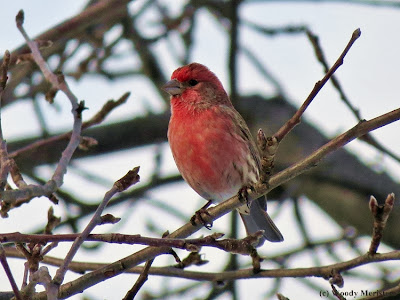February 17 –
It was 9° at the house this morning, but
the sky was a brilliant blue without a cloud. On the telephone cable along the
road a male cardinal was singing away. This wasn’t the short weak song we
typically hear on pleasant winter days – it was a full-throated territorial
song typical of spring.
Cardinals are year-round residents and maintain
their territories (although not too vigorously) throughout the winter. Earlier
in the winter three different pairs of cardinals visited our feeders, but since
the days of cold and snow have arrived there’s been but one pair here. Did the
other birds succumb to the weather or did the dominant pair drive them away?
Further down the road a small flock of robins fed on
the shriveled fruits of an ornamental crabapple.

Most years a few robins winter in the lowlands and
wetlands near the river. But, these birds weren’t near the river and it
appeared that all were males. Perhaps they were birds that have been wintering
in the area. Or, perhaps in spite of the snow and cold the most adventurous
male robins are heading north already. That would give them a chance to claim
the best territories, but also put them at risk of perishing in a late winter
storm – some years these early birds would win, some years they’d lose.
February 18 –
A male house finch in the apple tree displayed his bright breeding color and
was accompanied by a female, the only house finch to be seen near the house
this day.
For a few years many of the house finch we saw had
conjunctivitis that affected their eyes to the point that they couldn’t see
well if at all – it’s doubtful if any of those birds survived. But for the past
two years we’ve not seen a house finch with conjunctivitis. Presumably the
birds that were very susceptible to the disease were eliminated from the
population and birds that had some resistance remained to produce subsequent
generations. Survival of the fittest on display.

February 20 –
The flock of robins appeared at the house today, picking the fruits from an
ornamental holly at the corner of the house.
Some of them perched in a small white pine, seeming
to bask in the sunlight. They’re making the rounds of the neighborhood, feeding
on any remaining fruit they can find. The temperature was well over 40° F this
afternoon melting several inches of snow; but there’s still well over 15 inches
of snow on the ground. Will the snow melt before the fruit is gone?
February 21 –
Down along the river, in addition to the cold rain typical of early spring,
there were even more signs of spring: An immature Coopers hawk sat on a limb,
looking rather bedraggled in the rain. I’d prefer a lower temperature and
falling snow to rain at 36°, would the bird?
In the river there were some early migrants: a lone horned
grebe –
And several pairs of hooded mergansers –
The flower buds on the silver maples are swelling,
ready to burst into bloom. They're the first trees to flower in the northeast,
and do so long before their leaf buds open.
The signs of spring will be appearing more rapidly
now, and even though we may well have more snow and low temperatures, the
lengthening days are triggering changes in plants and animals that prepare them
for the arrival of another season.







No comments:
Post a Comment
Thanks for visiting "In Forest and Field" and thank you especially for commenting. It's always interesting to see other peoples' thoughts. Unfortunately, due to spam and trolls (not the kind living beneath bridges), comments must now be approved before being posted.
Woody